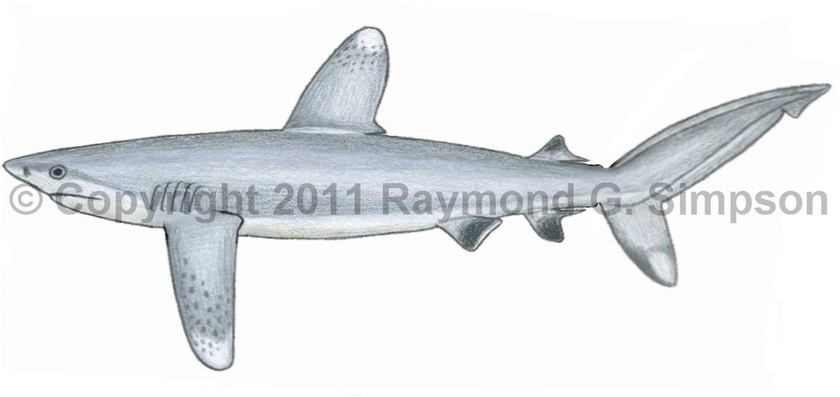
Common Name
Oceanic Whitetip Shark
Year Described
Poey, 1861
Identification
Anteroposterior tooth rows: 13-14/13-15 on each side; 28-32/27-31 total
Vertebrae: 123-131 precaudal, 228-244 total
A large and stout shark with a short and rounded snout. Eye small. Distance between nostrils 1.0-1.1 times in pre-oral distance. Nasal flaps rudimentary and very low. Upper labial furrows very short. Interdorsal ridge is present. Long preanal ridge absent. No keels on caudal peduncle. Gill slits long (3.0-4.1% TL). Teeth in upper jaws broadly triangular and serrated, with thick erect to oblique cusps. cusp. Lower jaw teeth broad-based and serrated, with heavy, erect cusps. First dorsal fin very high (9.2-15.2% TL) with a convex anterior margin, a broadly rounded tip, and inserted just posterior to inner margin of pectoral fin. Second dorsal fin much smaller (2.7-4.2% TL) and inserted almost directly above anal fin. Both dorsal fins with extended free posterior tips (second dorsal free tip less than twice height of second dorsal). Anal fin similar in size to second dorsal fin. Pelvic fin origin well behind free tip of first dorsal. Pectoral fin very long and broad, with obvious highly rounded edges.
Color
Gray, bronze, brownish, or blue-gray above, abruptly whitish below. First dorsal, pectoral, pelvic and caudal fins with distinct white tips and sometimes with a sprinkling of additional white spots. Sometimes with darker spots on fins (especially in younger specimens).
Size
Mature adults from 175-270cm TL. Newborns from 60-65cm. Maximum size to over 350cm TL.
Habitat
Usually pelagic from 0-152m over deep waters of the outer continental shelf, slope, and deeper waters. Rarely inshore.
Range
Oceanic: from New Jersey to Argentina, including Bermuda, the Gulf of Mexico, and the Caribbean Sea. Likely found in the entire open Atlantic in tropical and subtropical waters.
References
Castro, J.I. 2011. The Sharks of North America. Oxford University Press, 640 pp.
Compagno, L.J.V. 2002. Sharks. In: Carpenter, K.E. (Editor) FAO Identification Guide for Fishery Purposes. The Living Marine Resources of The Western Central Atlantic. Volume 1: Introduction, mollusks, crustaceans, hagfishes, sharks, batoid fishes, and chimaeras. ASIH Special Publication No. 5. FAO, Rome.
Compagno, L., M. Dando, and S. Fowler. 2005. Sharks of the World. Princeton University Press, 480 pp.